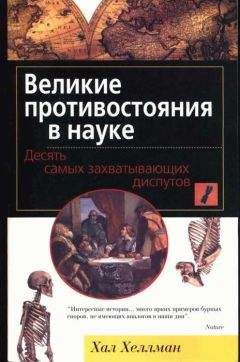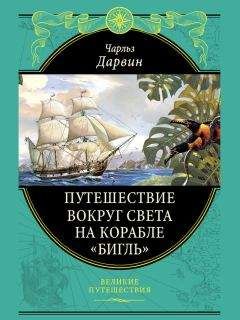Хал Хеллман - Великие противостояния в науке. Десять самых захватывающих диспутов

Помощь проекту
Великие противостояния в науке. Десять самых захватывающих диспутов читать книгу онлайн
da Silva, Wilson. «Human Origins Thrown into Doubt». New Scientist, March 29, 1997, p. 18.
Dorfman, Andrea, et al. «Not So Extinct After All». Time, December 23,1996, pp. 68–69.
Economist. «Ancestral Passions: The Leakey Family and the Quest for Humankind’s Beginnings». July 22,1995, v336n7924, p.83.
Economist. «Continental Drift». February 26,1994,p. 87. (Doubts about African origin of humans.)
Economist «Scientific Books: Origins». June 20, 1981, p. 113. Economist. «Skulls and Numbskulls». November 21, 1992, v325n7786, p. 103.
Falk, Dean. «The Mother of Us All?» Bioscience, February 1995, v45n2, pp. 108–110. (Review of Ancestors: In Search of Human Origins, by Johanson, Johanson, and Edgar.)
Freeman, Karen. «More Recent Migration of Humans from Africa Is Seen in DNA Study». New York Times, June 4, 1996, p. 11.
Gibbons, Ann. «Homo Erectus in Java: A 250000-Year Anachronism». Science, December 13,1996, v274, pp. 1841–1842.
Golden, Frederick. «First Lady of Fossils, Mary Nicol Leakey: 1913–1996». Time, December 23,1996, p. 69.
Gore, Rick. «Expanding Worlds». National Geographic, May 1997a, pp. 84–109.
Gore, Rick. «The First Steps». National Geographic, February 1997b, pp. 72–99. (Цикл статей «Происхождение человека».)
Gorman, Christine. «On Its Own Two Feet». Time, August 28, 1995, pp. 58–60.
Johanson, Donald C. «Face-to-Face with Lucy’s Family». National Geographic, March 1996, pp. 96–117.
Johanson, Donald С «A Skull to Chew On». Natural History, May 1993, pp. 52, 53. (Черный череп KNM-WT 17000 и параллельная эволюция.)
Johanson, Donald C, and Blake, Edgar. From Lucy to Language. New York: Simon & Schuster, 1996.
Johanson, Donald C, and Edey, Maitland. Lucy: The Beginnings of Humankind. New York: Simon & Schuster, 1981.
Johanson, Donald C, Johanson, Lenora, and Edgar, Blake. Ancestors: In Search of Human Origins. New York: Villard Books, 1994.
Johanson, Donald C, and Shreeve, James. Lucy’s Child: The Discovery of a Human Ancestor. New York: Morrow, 1989.
Johanson, Donald C, and White, Tim D. «A Systematic Assessment of Early African Hominids». Science, 1979, v202, pp. 321–330.
Kern, Edward P. H. «Battle of the Bones: A Fresh Dispute over the Origins of Man». Life, December 1981, pp. 109–120.
Kluger, Jeffrey. «Not So Extinct after AH». Time, December 23, 1996, pp. 68,69.
Larick, Roy, and Ciochon, Russell L. «The African Emergence and Early Asian Dispersals of the Genus Homo». American Scientist, November-December 1996, v84, pp. 538–551.
Leakey, Mary. Disclosing the Past: An Autobiography. Garden City, NY: Doubleday, 1984.
Leakey, Meave. «The Farthest Horizon». National Geographic, September 1995, pp. 38–51.
Leakey, Richard E. «Homo Erectus Unearthed (A Fossil Skeleton 1600000 Years Old)». National Geographic, November 1985, pp. 624–629.
Leakey, Richard E. The Making of Mankind. New York: E. P. Dutton, 1981.
Leakey, Richard E. One Life. Salem, MA: Salem House, 1984.
Leakey, Richard E. The Origin of Mankind. New York: Basic Books, 1994.
Leakey, Richard E.r and Lewin, Roger. Origins: In Search of What Makes Us Human. New York: E. P. Dutton, 1977.
Leakey, Richard E., and Lewin, Roger. Origins Reconsidered: In Search of What Makes Us Human. New York: Doubleday, 1992.
Lemonick, Michael D. «Picks & Pans: Ancestral Passions». People Weekly, October 2,1995, v44nl4, pp. 32,34.
Lewin, Roger. «Bones of Contention». New Scientist, November 4,1995, pp. 14,15.
Lewin, Roger. Bones of Contention: Controversies in the Search for Human Origins. New York: Simon & Schuster, 1987,
Lewin, Roger. «Family Feuds». New Scientist, January 24,1988, pp. 36–40.
Lovejoy, C. Owen. «The Origin of Man». Science, January 23, 1981, pp. 341–350.
Maddox, Brenda. «Hominid Dreams» (essay review of Ancestral Passions, by Morell). New York Times Book Review, August 6,1995, p. 28.
Major, John S. «The Secret of “Leakey Luck”» Time, August 28, 1995, p. 60.
McAuliffe, Sharon. «Lucy’s Father». Omni, May 1994, pp. 34-39, 80, 83–86.
Menon, Shanti. «Neanderthal Noses». Discover, March 1997, p. 30.
Morell, Virginia. Ancestral Passions: The Leakey Family and the Quest for Humankind’s Beginnings. New York: Simon & Schuster, 1995.
Morell, Virgina. «The Most Dangerous Game». New York Times
Magazine, January 7, 1996, p. 23. New York Times. «Richard Leakey: The Challenger in Dispute on Human Evolution». February 18, 1979, p. 41.
Nichols, Mark. «The Origins of Man». Maclean”s, December 23, 1996, v109n52, p. 69.
Pieg, Pascal, and Verrechia, Nicole. Lucy and Her Times. New York: Henry Holt, 1996. (Развлекательная книга о «первобытном мире».)
Pope, Gregory G. «Ancient Asia’s Cutting Edge». Natural History, May 1993, pp. 54–59. (Находки первобытных орудий в Китае.)
Rennie, John. «Fossils of Early Man: The Finds and the News». New York Times, June 25,1996, pp. CI, C9.
Rensberger, Boyce. «Rival Anthropologists Divide on “Pre-Human’ Find». Atea. York Times, February 18,1979, pp. 1, 41.
«Roots» («Human Origins, 1994», roundup). Discover, January 1995, pp. 37–42.
Shieeve, James. «”Lucy”, Crucial Early Human Ancestor, Finally Gets a Head». Science, April 1,1994, v264, pp. 34–35.
Shreeve, James. «Sexing Fossils; A Boy Named Lucy?» Science, November 24, 1995, v270, pp. 1297–1298.
Shreeve, James. «Sunset on the Savanna». Discover, July 1996, pp.116–125.
Tattersall, Ian. «Out of Africa Again… and Again?» Scientific American, April 1997, pp. 60–67.
Vrba, Elisabeth S. «The Pulse That Produced Us». Natural History, March 1993, pp. 47–51.
Walker, Alan, and Shipman, Pat. The Wisdom of the Bones: In Search of Human Origins. New York: Alfred A. Knopf, 1996.
Weaver, Kenneth F. «The Search for Our Ancestors». National Geographic, November 1985, pp. 560–623.
Wilford, John Noble. «Ancient German Spears Tell of Mighty Hunters of Stone Age». New York Times, March 4, 1997a, p. C. 6..
Wilford, John Noble. «The Leakeys: A Towering Reputation». New York Times, October 30,1984, pp. CI, C9.
Wilford, John Noble. «The New Leader of a Fossil-Hunting Dynasty». New York Times, November 7,1995, pp. CI, C6.
Wilford, John Noble. «Not About Eve». New York Times Book Review, February 2,1997b, p. 19.
Wilford, John Noble. «Three Human Species Coexisted Eons Ago, New Data Suggest». New York Times, December 13, 1996a, pp. 1, B14.
Wilford, John Noble. «2,3-Million-Year-Old Jaw Extends Human Family». New York Times, November 19, 1996b, pp. 1, C5.
Wilford, John Noble. «Which Came First, Tall or Smart?» New York Times Book Review, December 1, 1996c, p. 7. (Review of From Lucy to Language, by Johanson and Edgar.)
Willis, Delta. The Leakey Family: Leaders in the Search for Human Origins. New York: Facts on File, 1992.
10. Фриман против Mud
Brady, Ivan. «The Samoa Reader: Last Word or Lost Horizon?» (review of The Samoa Reader, by Hiram Caton). Current Anthropology, August-October 1991, v32n4, pp. 497–500.
Caton, Hiram. The Samoa Reader: Anthropologists Take Stock. Lanham, MD: University Press of America, 1990.
Cpte, James E. Adolescent Storm and Stress: An Evaluation of the Mead-Freeman Controversy. Hillsdale, NJ: Lawrence Erlbaum, 1994.
Cote, James E. «Much Ado about Nothing: The “Fateful Hoaxing” of Margaret Mead». Skeptical Inquirer, November/December 1998, v22n6, pp. 29–34.
Cote, James E. «Was Mead Wrong About Coming of Age in Samoa? An Analysis of the Mead/Freeman Controversy for Scholars of Adolescence and Human Development «.Journal of Youth and Adolescence, 1992, v21n5, pp. 499–527.
di Leonardo, Micaela. «Patterns of Culture Wars». Nation, April 8,1996, v262nl4, pp. 25–29.
Freeman, Derek. «Fa’apua’a Fa’amu and Margaret Mead». American Anthropologist, December 1989, v91n4, pp. 1017–1022.
Freeman, Derek. The Fateful Hoaxing of Margaret Mead: A Historical Analysis of Her Samoan Research. Boulder, CO: Westview, 1998.
Freeman, Derek. Margaret Mead and the Heretic: The Making and Unmaking of an Anthropological Myth. Ringwood (Australia): Penguin Books, 1996.
Freeman, Derek. Margaret Mead and Samoa: The Making and Unmaking of an Anthropological Myth. Cambridge, MA: Harvard University Press, 1983.
Freeman, Derek. «On Franz Boas and the Samoan Researches of Margaret Mead». Current Anthropology, June 1991,v32n3, pp. 322–330.
Freeman, Derek. «There’s Tricks I the World: An Historical Analysis of the Samoan Researches of Margaret Mead». Visual Anthropology Review, Spring 1991, v7, pp. 103–128.
Goodman, R. A. Mead’s Coming of Age in Samoa: A Dissenting View. Oakland, CA: Pipperline Press, 1983.
Grant, Nicole J. «From Margaret Mead’s Field Notes: What Counted as “Sex” in Samoa?» American Anthropologist, December 1995, v97n4, pp. 678–682.
Harris, Marvin. «Margaret and the Giant Killer». The Sciences, July-August 1983, v23, pp. 18–21.
Holmes, Lowell D. Quest for the Real Samoa: The Mead/Freeman Controversy & Beyond. South Hadley, MA: Bergin & Garvey Publishers, 1987.
Holmes, Lowell D. A Restudy ofManu”an Culture: A Problem in Methodology. Ph.D. dissertation, Northwestern University, 1957.
Holmes, Lowell D. «South Seas Squall: Derek Freeman’s Long-Nurtured, III-Natured Attack on Margaret Mead». The Sciences, 1983, v23, pp. 14–18.
Howard, Jane. Margaret Mead: A Life. New York: Simon & Schuster, 1984.
Kempermann, Gerd, Kuhn, H. George, and Gage, Fred H. «More Hippocampal Neurons in Adult Mice Living in Any Enriched Environment». Nature, April 3, 1997, v386n6624, pp. 493–495.
McDowell, Edwin. «New Samoa Book Challenges Margaret Mead’s Conclusions». New York Times, January 31, 1983, pp. 1, C21.
Mead, Margaret. Coming of Age in Samoa: A Psychological Study of Primitive Youth for Western Civilization. New York: American Museum of Natural History, 1973.
Monaghan, Peter. «Research on Samoan Life Finds New Backing for His Claims». Chronicle ofHigher Education, August 2, 1989, pp. A5, A6.
Muuss, R. E. Theories of Adolescence, fifth edition. New York:
Random House, 1988. Orans, Martin. «Mead Misrepresented». Science, March 12,
1999, v283, pp. 164–165.
Orans, Martin. Not Even Wrong: Margaret Mead, Derek Freeman, and the Samoans. Novato, CA: Chandler and Sharp Publishers, 1996.
Rensberger, Boyce. «The Nature-Nurture Debate: Two Portraits». Science 83, April 1983, v4n3. (1. Margaret Mead, pp. 28–37; 2. On Becoming Human [Edward O. Wilson], pp. 38–46.)
Rensberger, Boyce. «A Pioneer and an Innovator». New York Times, November 16, 1978, pp. 1, D18.
Rubin, Vera. «Margaret Mead and Samoa: The Making and Unmaking of an Anthropological Myth» (review). American Journal of Orthopsychiatry, July 1983, v53n3, pp. 550–554.
Shankman, Paul. «Margaret Mead, Derek Freeman, and the Issue of Evolution». Skeptical Inquirer, November/December 1998, v22n6, pp. 35–39.
Whitman, Alden. «Margaret Mead Is Dead of Cancer at 76». New York Times, November 16,1978, pp. 1, D18.
Wilson, Edward O. Sociobiology: The New Synthesis. Cambridge, MA: Harvard University Press, 1975.
Примечания
1
Данное явление получило название предпочтения положительных результатов — склонность исследователей и представителей периодических изданий к публикации результатов исследований, в которых чаще получены положительные результаты, нежели отрицательные. К положительным результатам относят те, которые позволяют обнаружить значимую корреляцию или возможную причинно-следственную связь хотя бы между двумя переменными. Отрицательными результатами считаются те, в которых не обнаруживают вообще никакого воздействия. — Примеч. ред.
2
Хотя приливы на Земле вызываются не движением планеты, приливы на вращающейся Земле отличаются от тех, какими они были бы на неподвижной планете. См., например, Burstyn, 1962.
























